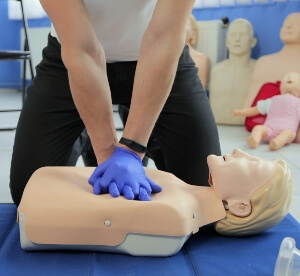Mon - Fri: 9 am - 5 pm
Online store always open
Mon - Fri: 9 am - 5 pm
Online store always open
GET CERTIFIED @ ONE OF OUR CONVENIENT TRAINING SITES!
[PITTSBURGH-LAWRENCEVILLE & CRANBERRY TOWNSHIP LOCATIONS]
NEED AN ONSITE CLASS AT YOUR LOCATION? CLICK HERE.

Western Pennsylvania and Pittsburgh Leader in CPR Classes | Master Zoll AED Distributor
AED stands for Automated External Defibrillator. An AED is a portable electronic device designed to be used by a layperson to deliver a shock to a victim who is in cardiac arrest.
Sudden Cardiac Arrest (SCA) claims over 350,000 lives in the United States each year. This is equivalent to 1 person every 90 seconds. SCA does not play favorites based on age and once a victim collapses, they only have minutes to survive. Having an AED onsite and knowing CPR can increase the victim’s survival rates and can make the difference between life and death.
Very easy! AEDs are made to be very layperson friendly so that a typical layperson can use the AED during a sudden cardiac arrest emergency while waiting for advanced medical professionals to arrive. AEDs even come equipped with audio and visual prompts to guide the rescuer through the entire process. Watch video above for a demo.
No. The biggest misconception with AEDs is that you can accidentally shock a victim that does not need a shock. This is incorrect. An AED will NOT activate the shock button and will NOT deliver a shock to a victim with a normal heart rhythm.
As quickly as possible. To achieve the highest survival rates, high-quality CPR and a shock from an AED need to be administered as soon as possible. Don’t wait for EMS to arrive to start the rescue as unfortunately it will be too late for most victims.
AEDs and CPR go hand-in-hand when it comes to cardiac arrest. You need both components for the highest survival rates.
Not a problem. The AED will let you know when to start compressing on the chest. The ZOLL AED Plus will even give you a beeping sound which is the rate at which you would need to compress, and the AED will tell you to “Push Harder” if you are not reaching at least 2 inches in depth. The ZOLL AED is the only AED in the world that can give the rescuer feedback on the depth of their CPR compressions.
Remember that every good Samaritan is covered by the Good Samaritan Act. If you are performing the rescue with good intent you are covered. The only liability that comes into play is if you do not maintain your AED and let the pads and batteries expire.
In standby mode, the adult pads and batteries for the ZOLL AED Plus have a shelf-life of 5 years. However, if the AED is used in a rescue, the pads and batteries will need to be replaced.
There is only a 50% chance that the AED will advise you to “shock” the victim, however, the AED will always prompt you to start chest compressions. Starting chest compressions is important because the victim could have a flat line (AEDs cannot shock a victim with a flatline) and therefore chest compressions become even more important. The AED will reanalyze the victim’s heart rhythm every 2 minutes and might be able to deliver a shock after the 2-minute mark.
You need to remove all clothing, dry the victim’s chest and shave the areas on the chest where the electrode pads will go on the chest. Remember that each set of pads have images to show you where they go on the chest. Each AED also comes with an accessory kit that includes scissors, dry razer, dry wipe, gloves, and a face shield/face mask.
You need to have good adhesion between the victim’s chest and the pad. If the victim has a hairy chest, the pad might not stick. This is an important step. Remember that one rescuer can (and should) be performing compressions on the chest, while another rescuer preps the victim’s chest.
Yes. All AEDs come with adult pads, however, pediatric pads might be available so always look for pediatric pads if you have a pediatric victim (under 8 years of age or under 55 lbs). Pediatric pads are usually found somewhere within the carry case of the AED.
Yes. The ZOLL AED Plus comes with a 5-year warranty. You can upgrade this to a 7-year warranty if you register your device online.
We always recommend that you perform a monthly maintenance check to make sure the green check mark is visible on the unit and that the expiration date of the pads is valid. The ZOLL AED Plus does perform an automated daily self-check, but the user can also perform a manual check if desired. If the batteries start to get low, the AED will beep at you like a smoke detector and the status indicator on the front of the unit will change to a red “X”.
AEDs are made that any layperson could pick up the unit, follow the prompts, and save a life. With that being said, we always recommend training if you have never had any.
Upon successful completion of the course, the completion card is valid for 2-years.
AEDs vary in price depending on brand, quantity, and if training is desired. The best thing to do is to contact us directly and we can provide you with an accurate quote.